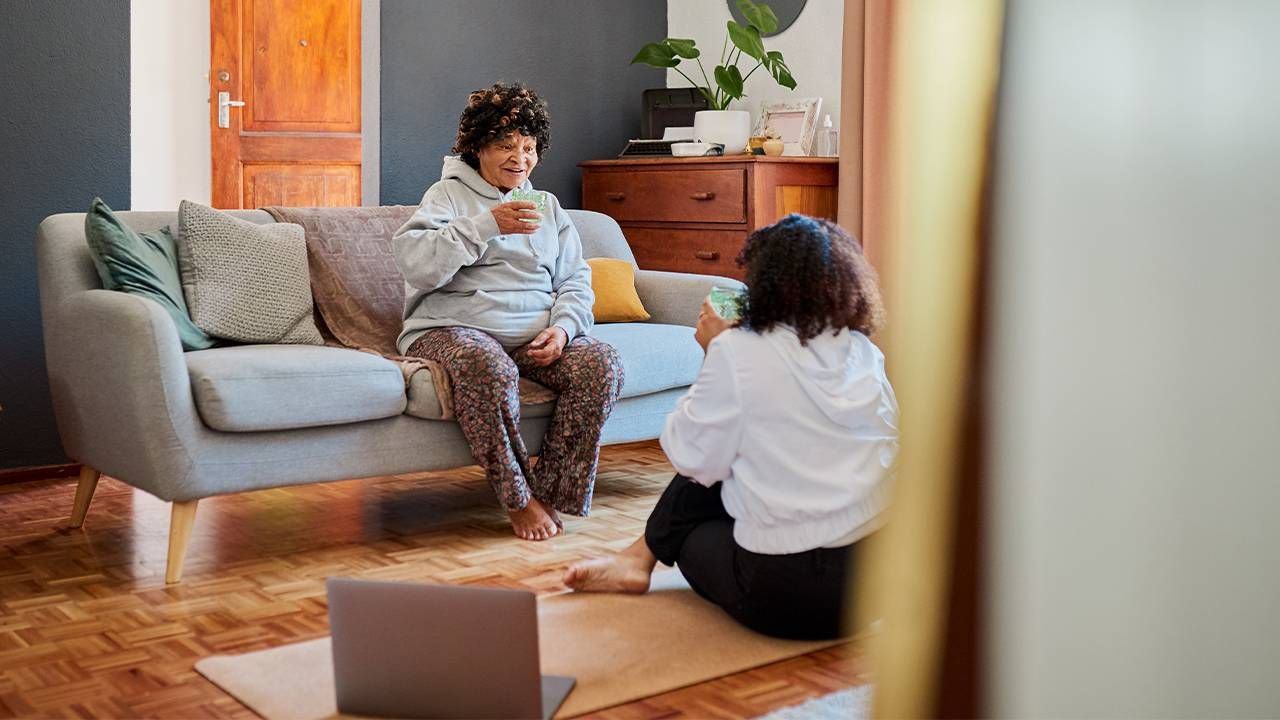Should You Be Worried About Your Parent's Sedentary Lifestyle?
Here are some suggestions on ways people of all fitness levels can stay active
I'm in the car with my husband when my sports watch vibrates. On the display is a crude stick figure jumping up and down.
Stop the car!" I cry out, jokingly. "I have to do some jumping jacks!" We both laugh, and he does not stop the car. I'm compulsive, but I'm not THAT compulsive.

While I do ignore my watch's intermittent entreaties to stop whatever I'm doing and jump around, I don't ignore my body. Most days I get in somewhere 8,000 and 10,000 steps (around 7,000 is the suggested number for good health).
I do this by playing pickleball three to five days a week, walking my dogs every day and running up and down the steps to my home office in search of my iPhone.
Much of what she complains about - lack of energy, mobility problems, poor circulation - has been shown to benefit from movement.
My 80-year-old mother-in-law, however, is another story.
She recently moved to a small apartment in the town where we live, and aside from weekly trips to Wal-Mart and her doctors, she spends all day and evening in front of her television.
It's a routine that I know isn't healthy for her, and that seems heroically unstimulating. But no amount of encouragement from us — to take a walk or find an activity outside of her home — has had any effect, other than to make her angry.
It's frustrating, because much of what she complains about — lack of energy, mobility problems, poor circulation — has been shown to benefit from movement.
But my mother-in-law is not alone. Only 39% of people over 65 meet the recommended amount of activity each week (see guidelines below), and that percentage decreases as age increases.
The average person sits 12 hours a day. As might be expected, there is a strong relationship between how much time adults spend being sedentary and the risk of cardiovascular disease, stroke and death. In fact, physical inactivity accounts for 9% of premature mortality worldwide according to the 2018 article "Sedentariness and Health: Is Sedentary Behavior More Than Just Physical Inactivity?" in Frontiers in Public Health.
What Constitutes Sedentary?
In general, sedentary behavior refers to doing anything that requires a low level of energy expenditure. Sitting or lying down, watching TV, playing video games, using a computer, driving and reading are the most common sedentary activities most of us engage in every day It only becomes a problem when it's all we do.
We are insufficiently active, according to the U.S. Department of Health and Human Services' site Health.gov, if we spend less than about 20 minutes every day moving with moderate intensity. Moderate intensity exercise is defined as anything that raises your heart rate. Brisk walks, water aerobics, riding a bike (real or stationary) and dancing are all moderate intensity exercises.
It's Not Your Fault If You Want to Rest
According to Harvard evolutionary scientist Daniel Lieberman, resting is hard-wired into our DNA. Before we had steady jobs and grocery stores, we were hunters and gatherers. Foraging for food was our exercise.
Brisk walks, water aerobics, riding a bike (real or stationary) and dancing are all moderate intensity exercises.
"No hunter-gatherer goes out for a jog, just for the sake of it," says Lieberman.
Rest — i.e. energy conservation — is what we did because we hadn't managed to catch anything to eat in a while. Now, although we are never at a loss for food, our sedentary time has increased, which means it's very easy to eat more than we need for survival, to eat worse (think processed) foods and to not steer those calories into energy expenditure.
When we don't move enough, our muscles waste away and bone repair slows. Which means the problem of not moving compounds: the less we move, the less we want to move.
Use It or Lose It
Most of us know that as we age, it's important to keep moving. But do you know how we benefit from staying active?
In addition to keeping our bones and muscles strong, regular physical activity (even gentle physical activity) has been shown to increase life expectancy; reduce our risk of contracting chronic diseases including Type 2 diabetes, heart disease and stroke; improve our balance; help us manage our weight and lower our risk of depression.
One study cited by the Centers for Disease Control and Prevention (CDC) found that reducing sitting time by 66 minutes each day reduced upper back and neck pain by 54%. Improved mental and physical health means we make fewer trips to the doctor, which can lower our health care costs, as disease prevention is less costly than treatment.
What Should You (Realistically) Aim For?
According to the CDC, older adults (which they define as 65 or older) should strive to engage in 2 1/2 to five hours a week of moderate-intensity activity, or 1 1/4 hours to 2 1/2 hours a week of vigorous-intensity aerobic activity. This includes adults with chronic diseases or disabilities (if possible).
At the very least, older adults should strive for 30 minutes of physical activity five days a week, divided between aerobic movement and strength training. Of course, many people are physically unable to meet these guidelines, in which case the CDC recommends engaging in "regular physical activity according to their abilities."
The bottom line is simple: avoid inactivity.
Where to Start?
Fortunately, there are lots of ways to get movement into our lives that don't require us to suit up and head out to the local gym.
Walking is a great way to get started, either outdoors or, if the weather isn't conducive or you're concerned about traffic, hills or uneven ground, in a shopping mall.
For the more adventurous, there's hiking, biking and swimming. Yard work such as raking leaves or pushing a lawn mower is great for aerobic fitness and strength training, as is lifting weights (hey, heavy grocery bags count!), doing push-ups and sit-ups, and gardening (especially when vigorous digging is involved).
Some forms of yoga are aerobic, while others are more strength-focused. My 92-year-old mother and her 97-year-old partner enjoy searching YouTube for yoga and fitness classes to suit their abilities and energy levels every day. They work out in a small bedroom, which goes to show that where there's a will, there's a way!
What If There's a Way, But Not a Will?
My mother-in-law will tell you that she moves plenty, as evidenced by the fact that she is tired at the end of the day. The irony is that increased movement would likely help her feel less tired.
So, what can we do when someone we care about staunchly refuses our entreaties to exercise — when the way is evident, but the will is absent? The National Institutes of Health has five ideas for people who are exercise resistant:
Know when to encourage, but know when to back off as well.
1) If you don't want to spend 30 minutes being active, break it into three 10-minute periods.
2) Take stairs instead of elevators, and park further from your destination. Every little bit counts.
3) Find an exercise buddy. You're more likely to stick with something when you are accountable to someone else.
3) Try something novel: a dance class, yoga or tai chi. A friend of mine started kickboxing— something she'd never done before — and at 50 got into the best shape of her life. Pickleball is fun and addictive and can be played by people of all ages and levels of ability. Even ping-pong will get you up and moving around.
4) Use family gatherings as a time to play team sports or do outdoor activities.
5) Get a sports watch and make racking up steps a challenge.
The Bottom Line
Movement has the potential to improve our physical conditioning and outlook. The key is to find something interesting and enjoyable that we will stick with.
That said, we can't always influence those we care about to do what's best for them, and it's not up to us to force our will on them. The adults in our life are free to make their own decisions and attempts to coerce them into doing what we think they should do can backfire, making someone who was resistant to making better health choices dig their heels in more.
Know when to encourage, but know when to back off as well.
As for my mother-in-law, I decided to circumvent the power struggle by contacting the pastor of a local church and asking if they would please reach out to her and invite her to become involved. He was more than happy to do it. Sometimes it can be helpful to call an impartial person in on the job.
Do check with your doctor before starting an exercise regimen if you've been sedentary for a while. Chances are they'll be happy to guide and encourage you in your new journey. Why not make moving more your 2022 New Year's resolution?

Read More

